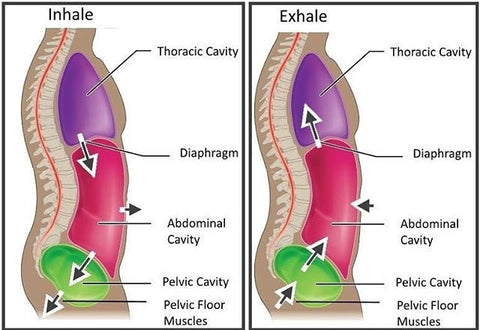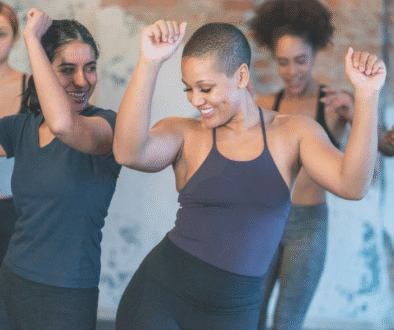Learning to Breathe – A Breath of Fresh Air
*Read the original article here: https://www.earthfedmuscle.com/blogs/articles/learning-to-breathe-a-breath-of-fresh-air
There are only a few activities that your body is constantly engaging in. Your heart is beating, your brain’s synapses are firing, and your lungs are breathing. These are all automatic actions, but you can only take direct control over one: breathing. Due to its nature as simultaneously voluntary and involuntary, breathing has been referred to as the bridge between the body and the mind. Controlling your breath can open up entirely new possibilities for your movement and mental health.
The average person breathes around 12-15 times per minute1. How? Our lungs aren’t muscular tissue, so they can’t breathe on their own. There are numerous muscles throughout the head, neck, and trunk that contribute to breathing, but none are more important than the diaphragm. The diaphragm is a sheet of muscle and connective tissue shaped like a dome, which connects to the structure of the lungs above, the ribs and spine in front of and behind, and the rest of the internal organs below(1).
To initiate the first phase of breathing, or inspiration, the diaphragm contracts, creating negative pressure that draws air into the lungs. The final phase of breathing, expiration, involves the diaphragm relaxing and assisting the natural elasticity of the lungs in expelling air. The diaphragm naturally contracts and relaxes fully when we are born, allowing for efficient exchange of oxygen and carbon dioxide in the lungs(2). The benefits of full diaphragmatic action go well past just gas exchange. Studies have shown that abdominal breathing involving the diaphragm is important for cerebrospinal fluid flow in the spine, and have even suggested that deep breathing practices can augment our ability to learn new motor patterns(3,4).

The diaphragm and breath play an important role in the body’s movement as well. Those physical links between the diaphragm and your skeletal structure mean you can influence your trunk by breathing properly. The ribs form a solid but flexible cage around the upper two thirds of the trunk, and the diaphragm can influence them and their connection with the spine(1). This means the diaphragm and the breath along with it play a key role in stabilizing and mobilizing the thoracic spine. The thoracic spine consists of the space in your spine between the bottom of your neck and the bottom of your ribs. This region supports your shoulders and abdomen and is critical to athletes, as it drives basically all functional movements in your upper limbs–like pressing and pulling(5).
Below the diaphragm sits your pelvis, which serves as the connection between your lower and upper body. The pelvis connects to the abdomen and spine above, and the glutes and lower body muscles to its sides and below. The muscles of the pelvis are rhythmically connected to the respiratory muscles like the diaphragm, matching contractions to support stable function of respiration and the organs of the abdomen. Proper pelvic contractions are also coupled with the diaphragm and abdomen to support posture through the body, creating a stable muscular chain to transmit power, something all athletes need to do!

The necessity of breathing goes beyond structural support. Breath is a link between the mind and body, and holds influence over mental states . Disrupted breathing will change the mixture of gas in the blood, often meaning less oxygen and more carbon dioxide, changing pH. Your body is extremely sensitive to blood levels of CO2, and research has shown that higher relative levels of CO2 is directly linked to anxiety and panic-like states in children(6). A state of panic creates a positive feedback cycle in relation to breathing. Short, tight breaths leave more CO2 in the blood, which increases the body’s panic reaction, which tends to quicken and shorten the breath, further increasing CO2 levels. Think of panic attacks you’ve witnessed – short, fast breathing perpetuates the state.
Taking greater control of the breath can break this cycle and normalize your mental state. Relaxed, deep breathing has been shown to modify brain waves and brain region activity to promote greater function in the prefrontal cortex, which can promote voluntary emotional control(7). Deep breathing also correlates with more parasympathetic nervous system tone, promoting recovery and physical relaxation, both of which are important states for athletic performance. It’s difficult to perform at a high level if you’re physically and mentally tight, and breathing is an easy way to relax on command.
To perform complex movements well, your mind and body need to work in concert, and breathing forms a bridge between the two. A 2014 study showed that breathing pattern disorders have a negative impact on individuals’ score on a functional movement screening. The subjects who improperly engaged their diaphragm struggled with muscular imbalance and motor control, and scored poorly on the functional movement screening, which is strongly correlated with injury risk8. Mentioned above, a 2016 study had participants engage in 30-minute sessions of deep, controlled breathing. The authors of the study then saw participants significantly improve their retention of a newly learned motor task after the breathing practice(4).
The structural and neurological implications of diaphragmatic breathing discussed above show the necessity of proper breathing throughout all movements, even improving new patterns. Gray Cook, a physical therapist on the team behind Functional Movement Systems has noted that if his patients need to adjust a movement in order to breathe, “they don’t own that motion because they can’t breathe there.”(9). Combining the structurally supportive and neurologically relaxing power of the breath into every movement is key to ensuring that you’re utilizing the proper movement systems and giving your nervous system the engagement it needs to ingrain and repeat those movements properly.
All this talk about the necessity of breathing well, but how should you breathe? Many experts suggest, “it depends.” While stretching, you might want to harness the relaxing power of exhalation to fall into a deeper position, but you’ll want to breathe differently if you’re moving under a heavy load, like in a back squat. For a movement like that, you’ll want to focus on your inhale to produce pressure in your abdomen that will support your trunk, and possibly even exaggerate an exhale to increase your power output(10).
In sport, you’ll have to adjust your breathing patterns to match your desired goals. In life, however, a good place to start is re-engaging your diaphragm as the main driver of the breath. A simple guide is to focus on belly breathing. You can practice this by lying on your back, with one hand on your stomach and another on your chest. When you breathe in, focus on pulling the air into your belly, and you should feel the hand on your stomach rise, while the hand on your chest stays relatively still. Breathe out and feel the lower hand fall again. Repeat this cycle and try to breathe as deeply as you can, both in and out. With even a few minutes of this practice, you should start to see some of the benefits that can be found just by controlling your breath.
Set yourself a goal of practicing breathing a few times a week. Then, once you’ve got the mechanics, try using it to your benefit. Focus on your breath while you’re stretching, engaging full inhalation and exhalation. The next time you try a new movement or position, see if you can breathe fully while holding it. If not, you have some work to do. While mastering your breath will supplement your athletic performance, it will give your mental state a major boost in the process, like a breath of fresh air!
Bibliography
- Blandine Calais-Germain. Anatomy of Breathing. Seattle, Wa, Eastland Press, 2006.
- Harvard Health Publishing. “Learning Diaphragmatic Breathing – Harvard Health.” Harvard Health, Harvard Health, 2019, www.health.harvard.edu/lung-health-and-disease/learning-diaphragmatic-breathing.
- Aktas, Gokmen, et al. “Spinal CSF Flow in Response to Forced Thoracic and Abdominal Respiration.” Fluids and Barriers of the CNS, vol. 16, no. 10, 4 Apr. 2019, fluidsbarrierscns.biomedcentral.com/articles/10.1186/s12987-019-0130-0. Accessed 12 Dec. 2020.
- Yadav, Goldy, and Pratik K. Mutha. “Deep Breathing Practice Facilitates Retention of Newly Learned Motor Skills.” Scientific Reports, vol. 6, no. 1, 14 Nov. 2016, www.nature.com/articles/srep37069, 10.1038/srep37069. Accessed 13 Dec. 2019.
- Heneghan, Nicola R., et al. “Thoracic Spine Mobility, an Essential Link in Upper Limb Kinetic Chains in Athletes: A Systematic Review.” Translational Sports Medicine, vol. 2, no. 6, 23 Sept. 2019, pp. 301–315, 10.1002/tsm2.109. Accessed 27 Mar. 2020.
- Rappaport, Lance M., et al. “Clinical Correlates of Carbon Dioxide Hypersensitivity in Children.” Journal of the American Academy of Child & Adolescent Psychiatry, vol. 56, no. 12, Dec. 2017, pp. 1089-1096.e1, 10.1016/j.jaac.2017.09.423. Accessed 15 Dec. 2020.
- Zaccaro, Andrea, et al. “How Breath-Control Can Change Your Life: A Systematic Review on Psycho-Physiological Correlates of Slow Breathing.” Frontiers in Human Neuroscience, vol. 12, 7 Sept. 2018, www.ncbi.nlm.nih.gov/pmc/articles/PMC6137615/, 10.3389/fnhum.2018.00353.
- Bradley, Helen, and Joseph Esformes. “BREATHING PATTERN DISORDERS AND FUNCTIONAL MOVEMENT.” International Journal of Sports Physical Therapy, vol. 9, no. 1, Feb. 2014, www.ncbi.nlm.nih.gov/pmc/articles/PMC3924606/. Accessed 12 Dec. 2020.
- Cook, Gray, and Stuart McGill. “GRAY COOK & STUART MCGILL DISCUSS BREATHING ASSESSMENT.” On Target Publications, 2015, www.otpbooks.com/breathing_assessment/?ref=19&utm_source=On+Target+Publications+Main+List&utm_campaign=92669fade8-OTP_breathing_assessment&utm_medium=email&utm_term=0_a094b1f4dc-92669fade8-37078713&mc_cid=92669fade8. Accessed 12 Dec. 2020.
- Jones, Brett. “How Your Breathing Relates to Your Movement | Functional Movement Systems.” Www.Functionalmovement.com, 10 May 2017, www.functionalmovement.com/articles/769/how_your_breathing_relates_to_your_movement. Accessed 15 Dec. 2020.



